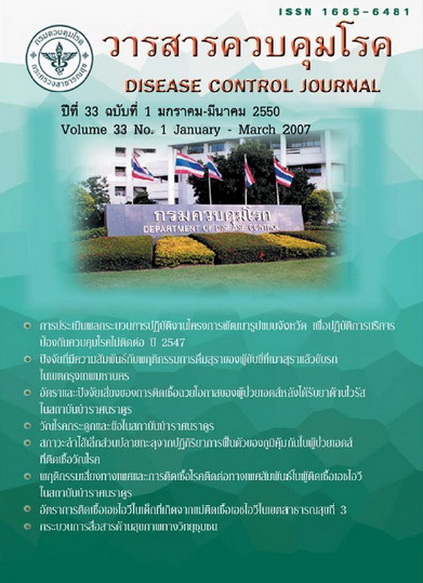Rate and Risk Factors of Major Opportunistic Infections in HIV/AIDS Patients after Antiretroviral Therapy at Bamrasnaradura Infectious Diseases Institute
Keywords:
HIV/AIDS patients, Antiretroviral drugs, Bamrasnadarura Infectious Diseases InstituteAbstract
The objectives of this study were to determine the incidence and risk factors for new episodes ofmajor opportunistic infections (OIs) after antiretroviral therapy (ART) among HIV-infected patients. A retrospective cohort study was conducted among naïve HIV-infected patients who were initiated ART between January 2001 and December 2003 at Bamrasnaradura Infectious Diseases Institute. Patients were categorized into two groups based on baseline CD4 cell counts: group A ( 50 cells/mm3) and group B (>50 cells/mm3). All patients were followed for 15 months after ART initiation. There were 793 patients with a mean age of 35.1±7.4 years and 56% were male. Among793 patients, 531 (67.0%) were in group A and 262 (33.0%) were in group B. Median (IQR) CD4 cell count was 13 (6-26) cells/mm3 in group A and 116 (78-167) cells/mm3 in group B. Median (IQR) baseline plasma HIVRNA was 300,500 (138,500-556,000) copies/ml and 185,000 (68,000-577,500) copies/ml in groupA and group B, respectively (P<0.05). Group A had a higher proportion of male, previous OIs, body weight, transaminase enzymes (P<0.05). Incidence of major OIs (i.e., tuberculosis, cryptococcosis, pneumocystis, histoplamosis and CMV disease) at 1, 3, 6, and 12 months after ART were 2.9%, 6.8%, 8.6% and 10.2% in group A and 1.9%, 1.9%, 3.1% and 3.5% in group B respectively (log rank test, P=0.001). Cox's proportional hazard model showed that the patients with baseline CD4 cell count 50 copies/ml was associated with high incidence of OIs after initiation of ART (P=0.017, HR=4.4, 95% CI=1.307-14.493). In conclusion, HIV-infected patients who had baseline CD4 50 cells/mm3 had a higher probability of the occurrence of major OIs after initiation of ART than those who had baseline CD4>50cells/mm3. Closed monitoring of clinical conditions should be strongly recommended after ART initiation in patients with low baseline CD4 cell counts.
References
2. Ledergerber B, Egger M, Erard V, et al. AIDSrelated opportunistic illnesses occurring after initiation of potent antiretroviral therapy: the Swiss HIV Cohort Study. JAMA. 1999; 282: 2220-6
3. Palella FJ, Jr., Delaney KM, Moorman AC, et al. Declining morbidity and mortality among patients with advanced human immunodeficiency virus infection. HIV Outpatient Study Investigators. N Engl J Med. 1998; 338: 853-60
4. Lawn SD, Bekker LG and Miller RF. Immune reconstitution disease associated with mycobacterial infections in HIV-infected individuals receiving antiretrovirals. Lancet. 2005; 5: 361-73
5. Shelburne SA, 3rd, Hamill RJ, Rodriguez-Barradas MC, et al. Immune reconstitution inflammatory syndrome: emergence of a unique syndrome during highly active antiretroviral therapy. Medicine (Baltimore) 2002; 81: 213-27
6. Annual Report. Bamrasnaradura Infectious Diseases Institute.
7. Ruxrungtham K, Phanuphak P. Update on HIV/AIDS in Thailand. J Med Assoc Thai. 2001; 84 Suppl 1: S1-17
8. Michelet C, Arvieux C, Francois C, et al. Opportunistic infections occurring during highly active antiretroviral treatment. Aids 1998; 12:1815-22
9. Lipman M, Breen R. Immune reconstitution inflammatory syndrome in HIV. Curr Opin Infect Dis. 2006; 19: 20-5
10. Ledergerber B, Egger M, Opravil M, et al.Clinical progression and virological failure on highly active antiretroviral therapy in HIV-1 patients: a prospective cohort study. Swiss HIV Cohort Study. Lancet. 1999; 353: 863-8
11. Badri M, Ehrlich R, Wood R, Pulerwitz T and Maartens G. Association between tuberculosis and HIV disease progression in a high tuberculosis prevalence area. Int J Tuberc Lung Dis. 2001; 5: 225-32
12. Corbett EL, Watt CJ, Walker N, et al. The growing burden of tuberculosis: global trends and interactions with the HIV epidemic. Arch Intern Med. 2003; 163: 1009-21
13. Whalen CC, Nsubuga P, Okwera A, et al. Impact of pulmonary tuberculosis on survival of HIV-infected adults: a prospective epidemiologic study in Uganda. AIDS. 2000; 14: 1219-28
14. Carcelain G, Debre P and Autran B. Reconstitution of CD4+ T lymphocytes in HIV-infected individuals following antiretroviral therapy. Curr Opin Immunol. 2001; 13: 483-8
15. Imami N, Antonopoulos C, Hardy GA, Gazzard B and Gotch FM. Assessment of type 1 and type 2 cytokines in HIV type 1-infected individuals: impact of highly active antiretroviral therapy. AIDS Res Hum Retroviruses. 1999; 15: 1499-508
16. Lederman MM. Immune restoration and CD4+T-cell function with antiretroviral therapies. AIDS. 2001; 15 Suppl 2: S11-5
Downloads
Published
How to Cite
Issue
Section
License
Articles published in the Disease Control Journal are considered as academic work, research or analysis of the personal opinion of the authors, not the opinion of the Thailand Department of Disease Control or editorial team. The authors must be responsible for their articles.



.png)



